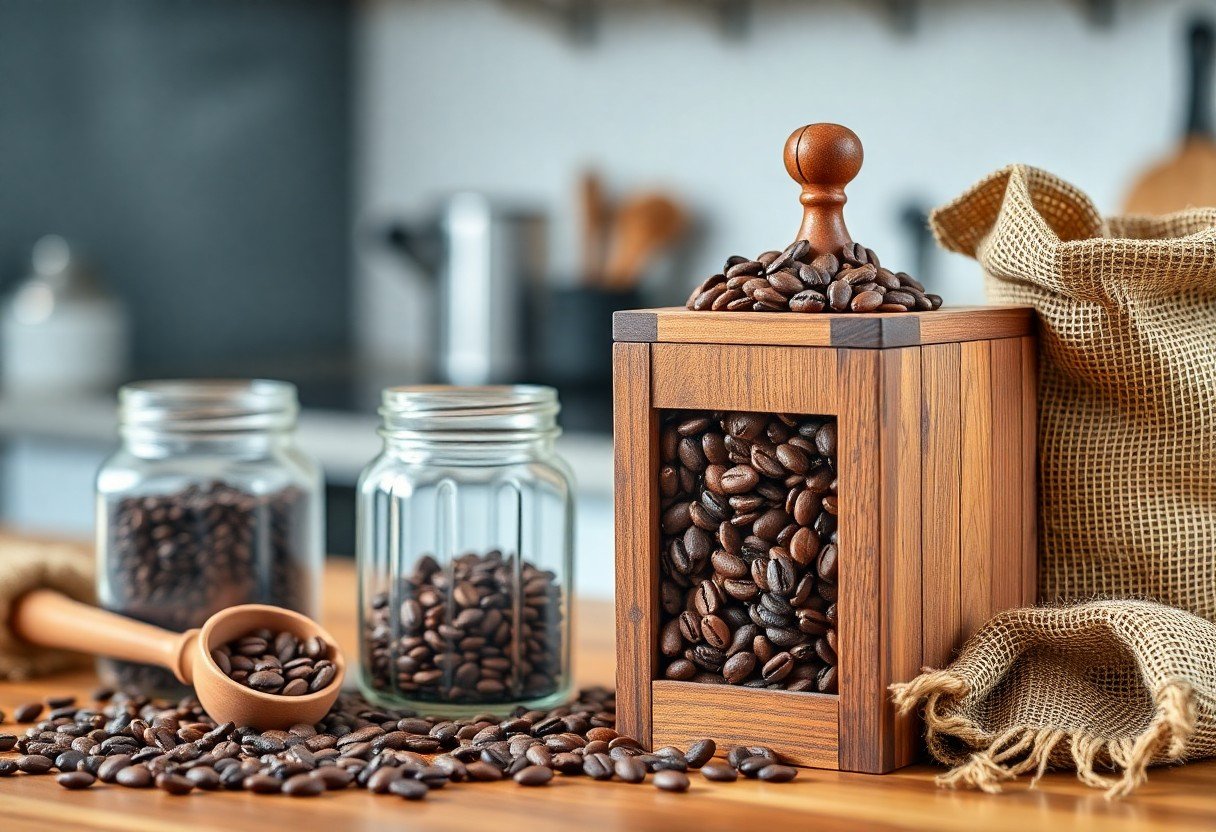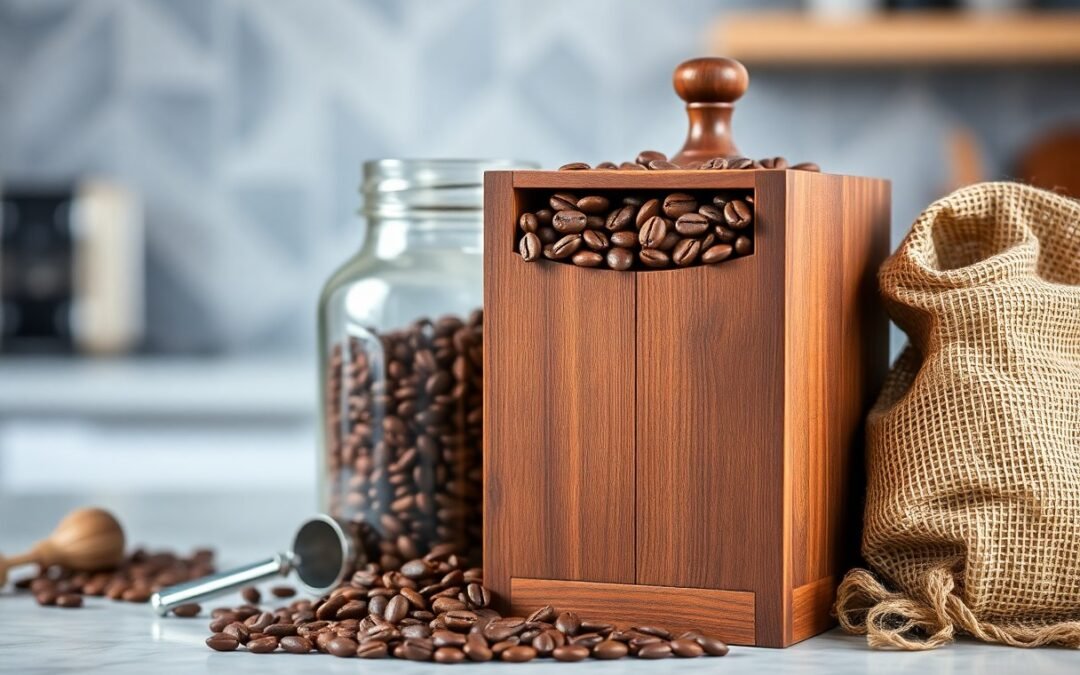The Quest for Coffee Freshness
The journey to brew the perfect cup starts long before the kettle boils; it begins with the beans themselves. Freshly roasted coffee begins to lose its optimal flavor within just weeks. Ideally, you should use beans within two to four weeks after roasting for the best taste experience, as this is when their aromatic oils are most vibrant. Consider this: coffee loses up to 50% of its flavor compounds after only a month if not stored properly. Investing in high-quality, whole beans is only half the battle; proper storage becomes your secret weapon in protecting those exquisite flavors.
The Ideal Environment for Coffee Storage
Storing your fresh coffee beans in the right environment is important to preserving their flavor profile and aroma. Ideally, you want to keep your beans in an area that is cool, dark, and dry. This means avoiding cabinets near ovens, sunny countertops, or humid basements. The right environmental factors can significantly extend the life of your coffee, allowing you to enjoy each brew at its best.
Temperature and Its Impact on Flavor
Temperature plays a pivotal role in flavor degradation. Heat accelerates the process of oxidation, which can quickly diminish the quality of your coffee. Aim to store your beans at a consistent temperature, ideally between 60°F to 70°F (15°C to 21°C). Fluctuations can cause expansion and contraction of the oils within the beans, further impacting taste.
Temperature Effects on Coffee Beans
| Temperature Range | Impact on Flavor |
|---|---|
| Below 60°F (15°C) | Holds freshness, but can slow aging too much. |
| 60-70°F (15-21°C) | Optimal storage temperature for flavor retention. |
| Above 70°F (21°C) | Increases oxidation and diminishes flavor complexity. |
Humidity Levels: Finding the Sweet Spot
Humidity significantly influences the freshness and integrity of your coffee beans. Aim for a relative humidity level between 30% to 60%. Lower humidity can cause beans to become brittle and dried out, while high humidity can lead to mold growth and deterioration. It’s a delicate balance that, if achieved, allows your beans to release their full flavor potential.
Excess moisture is particularly harmful as coffee beans are porous and can absorb water. This not only alters flavor but can also develop unwanted aromas. Using a hygrometer can help monitor humidity levels in your storage space, ensuring you’re within the ideal range. Consider using airtight containers to reduce exposure to external humidity and further protect your beans’ flavor integrity.

Choosing the Right Storage Container
Selecting the appropriate storage container for your coffee beans can significantly impact their freshness. Opt for a container that offers protection from light, air, heat, and moisture. Look for opaque designs to block out light, which can degrade coffee, and make sure your chosen container has a capacity that minimizes unnecessary air exposure. A well-designed container will sustain your coffee’s optimal flavor for longer periods, ensuring you enjoy every cup to its fullest potential.
Material Matters: Glass vs. Plastic
Glass and plastic are two popular materials for coffee storage, each boasting unique advantages. Glass containers are non-porous, ensuring that your beans remain free from any chemical leaching or unwanted odors. On the other hand, high-quality plastic options can be lightweight and unbreakable, making them a practical choice for everyday use. While both can effectively store coffee, glass is often preferred for its ability to perfectly seal in flavor without imparting any unwanted tastes.
The Role of Airtight Seals
Airtight seals are fundamental in preventing oxygen from deteriorating your coffee beans. Exposure to air triggers the oxidation process, which not only diminishes flavor but also causes beans to become stale more quickly. Look for containers with robust sealing mechanisms, such as silicone gaskets or clamp lids, to maintain a barrier against air. Investing in a container with an airtight seal can extend the shelf life of your coffee, allowing you to savor its rich flavors longer without compromising quality.
Avoiding Flavor Saboteurs
Protecting your coffee beans from flavor saboteurs will ensure your brew maintains its intended taste. Various environmental factors can compromise the integrity of your beans, leading to a dull and stale cup. By minimizing exposure to light, odor, and moisture, you can keep your coffee tasting vibrant and fresh for longer periods.
Light and Its Detrimental Effects
Light is one of the biggest enemies of freshly roasted coffee beans. Exposure to light, especially sunlight, causes chemical reactions that degrade the beans’ quality, leading to a loss of aromatic compounds. Therefore, always store your coffee in an opaque, airtight container placed in a dark location to shield it from harmful light.
Odor Contamination: Protecting Your Beans
Odor contamination can significantly detract from your coffee’s flavor. Coffee beans are like sponges, absorbing surrounding odors easily. To avoid this, store your beans in an airtight container away from strong-smelling items like spices, onions, or cleaning products. This simple step will help maintain the pure essence of your coffee.
Consider the fact that coffee beans can absorb odors even through the packaging if not properly stored. For instance, a subtle scent emanating from your refrigerator can quickly infiltrate your coffee stash, altering its flavor profile. To combat this, opt for a dedicated coffee container that remains sealed and is kept away from any potential odor sources. Investing in quality airtight containers can be transformative, ensuring your morning brew stays true to its original flavor notes and aroma.

How to Store Various Coffee Bean Types
Proper storage varies depending on the type of coffee beans you have. Each variety has its nuances in maintaining freshness. Below are a few key considerations:
- Whole Beans: Store in an airtight container in a cool, dark place.
- Ground Coffee: Use immediately if possible; store in an airtight container for short-term use.
- Specialty Beans: Keep them in their original packaging or in opaque, vacuum-sealed containers.
- Flavored Beans: Store them separately from unflavored beans due to potential flavor transfer.
- Decaf Beans: Follow the same storage guidelines as regular beans but use them sooner.
Thou shalt always ensure your coffee remains fresh, no matter what variety you choose.
| Type of Coffee Beans | Storage Method |
| Whole Beans | Airtight container in a cool, dark place |
| Ground Coffee | Airtight container; use promptly |
| Specialty Beans | Opaque vacuum-sealed container |
| Flavored Beans | Store separately from unflavored |
| Decaf Beans | Follow same guidelines as regular beans |
Whole Beans vs. Ground Coffee
Whole beans are the gold standard for preserving freshness; grinding releases oils and volatile compounds that can quickly fade. If you opt for ground coffee, store it in an airtight container and use it within a week to maximize flavor. The goal is to minimize exposure to air, light, and moisture that can hasten deterioration.
Specialty Beans: Unique Considerations
Specialty beans often come with their unique characteristics and flavors that can be sensitive to environmental changes. Their provenance and processing techniques require careful storage to preserve their exclusive profiles. Typically, these beans should remain in their original bags, which often incorporate features to retain freshness.
In the matter of specialty beans, factors such as the roast date, origin, and even the varietal play a role in storage. For example, coffees from higher altitudes may have distinct flavors that are very prone to loss if exposed to air. Using opaque, vacuum-sealed containers can be beneficial for these beans, as they eliminate light exposure. Additionally, storing the beans at a consistent temperature will help keep them fresher longer. You should always indulge in specialty beans fresh after opening their packaging to savor the most authentic taste experience.
Maximizing Freshness with Timed Consumption
Timing can significantly enhance your coffee experience. By consuming your coffee beans within a specific timeframe after roasting, you ensure the maximum flavor and aroma. Generally, beans are best enjoyed within 2 to 14 days post-roast, as they stabilize and develop their optimal taste during this window. Beyond two weeks, the quality tends to decline, leading to a flatter flavor profile. Being aware of when your beans were roasted helps you to enjoy each cup at its freshest.
Understanding Roast Dates
Roast dates serve as your coffee’s “best by” marker, indicating when the beans reached peak flavor. Freshness is vital; the closer you are to the roast date, the richer your coffee will taste. Ideally, you should seek out beans roasted within the past few weeks, keeping in mind that once opened, beans are exposed to air which accelerates stale flavors. This date helps you track when it’s time to reorder and keeps your coffee routine refreshed.
Batch Brewing: Using Fresh Beans Wisely
Employing batch brewing techniques allows you to take full advantage of your fresh coffee beans while minimizing waste. By preparing coffee in larger quantities, you can cater to multiple cups at once, yet it is vital to pay attention to the timing. Ideally, brew only what you can consume within a couple of hours for optimal flavor. Any leftover coffee should be stored in an insulated vessel to maintain warmth without further extraction.
Batch brewing not only maximizes the use of fresh beans but also simplifies your morning routine. Instead of grinding and brewing a single cup at a time, you can prepare a full pot to serve. This method saves time and allows you to get the most out of your preference for freshly roasted coffee. Aim to brew in smaller batches every few hours instead of a large pot at once; this ensures each serving maintains that vibrant, freshly-ground taste. Just keep in mind to drink your coffee while it’s still hot to appreciate the full spectrum of flavors.
Final Words
Hence, by following the proper storage methods for your fresh coffee beans, you can significantly enhance their flavor and aroma, leading to the perfect cup every time. Ensure you keep your beans in a cool, dark place, and use airtight containers to shield them against moisture and air. For more detailed guidance, check out this valuable resource on How To Store Coffee Beans, According To An Expert. Your daily coffee experience deserves the best care.
FAQ
Q: How should I initially store my fresh coffee beans after purchasing them?
A: After purchasing your fresh coffee beans, it’s best to keep them in their original packaging until you’re ready to use them. Most coffee comes in bags that are designed to keep out light, air, and moisture. If the bag is not resealable, consider transferring the beans to an airtight container. Ensure that the container is opaque to protect the beans from light exposure, which can compromise their flavor.
Q: What is the best environment for storing coffee beans to maintain their freshness?
A: Coffee beans thrive when stored in a cool, dark place. The optimal temperature for storage is between 60°F to 70°F (15°C to 21°C). Avoid places like the refrigerator or kitchen cupboards that may experience fluctuations in temperature. It’s important to choose a location away from heat sources, such as ovens or stovetops, as well as direct sunlight, both of which can cause the beans to deteriorate faster.
Q: Is it advisable to freeze coffee beans to preserve their freshness?
A: Freezing coffee beans is a method some people use to extend their shelf life, but it requires careful consideration. If you choose to freeze your beans, make sure to portion them into smaller bags or containers that can be sealed tightly. Only take out what you need at a time, as repeated thawing can introduce moisture and negatively affect the flavor. If done correctly, freezing can help maintain freshness for a longer period, but for everyday use, storing beans in a cool, dry place is usually sufficient.

